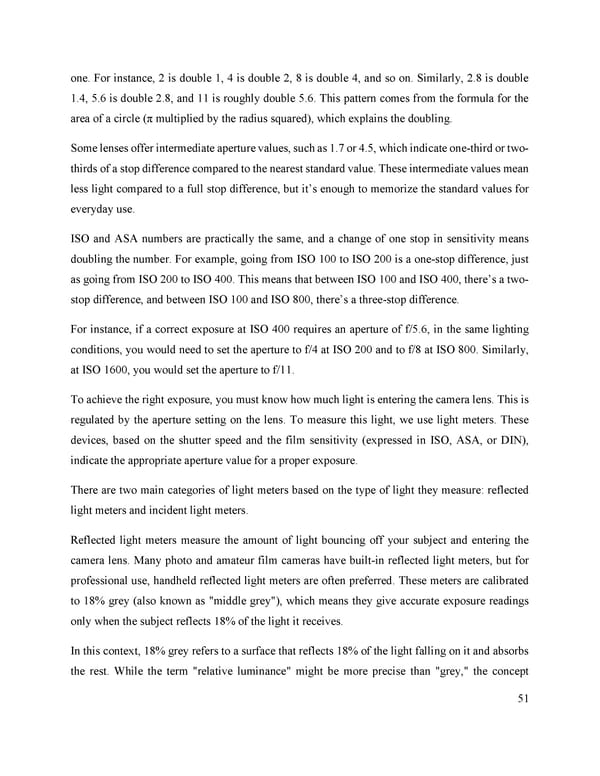one. For instance, 2 is double 1, 4 is double 2, 8 is double 4, and so on. Similarly, 2.8 is double 1.4, 5.6 is double 2.8, and 11 is roughly double 5.6. This pattern comes from the formula for the area of a circle (π multiplied by the radius squared), which explains the doubling. Some lenses offer intermediate aperture values, such as 1.7 or 4.5, which indicate one-third or two- thirds of a stop difference compared to the nearest standard value. These intermediate values mean less light compared to a full stop difference, but it’s enough to memorize the standard values for everyday use. ISO and ASA numbers are practically the same, and a change of one stop in sensitivity means doubling the number. For example, going from ISO 100 to ISO 200 is a one-stop difference, just as going from ISO 200 to ISO 400. This means that between ISO 100 and ISO 400, there’s a two- stop difference, and between ISO 100 and ISO 800, there’s a three-stop difference. For instance, if a correct exposure at ISO 400 requires an aperture of f/5.6, in the same lighting conditions, you would need to set the aperture to f/4 at ISO 200 and to f/8 at ISO 800. Similarly, at ISO 1600, you would set the aperture to f/11. To achieve the right exposure, you must know how much light is entering the camera lens. This is regulated by the aperture setting on the lens. To measure this light, we use light meters. These devices, based on the shutter speed and the film sensitivity (expressed in ISO, ASA, or DIN), indicate the appropriate aperture value for a proper exposure. There are two main categories of light meters based on the type of light they measure: reflected light meters and incident light meters. Reflected light meters measure the amount of light bouncing off your subject and entering the camera lens. Many photo and amateur film cameras have built-in reflected light meters, but for professional use, handheld reflected light meters are often preferred. These meters are calibrated to 18% grey (also known as "middle grey"), which means they give accurate exposure readings only when the subject reflects 18% of the light it receives. In this context, 18% grey refers to a surface that reflects 18% of the light falling on it and absorbs the rest. While the term "relative luminance" might be more precise than "grey," the concept 51
 Lost Analogue: Exploring Film, Music, and Interdisciplinary Methods in Education Page 51 Page 53
Lost Analogue: Exploring Film, Music, and Interdisciplinary Methods in Education Page 51 Page 53